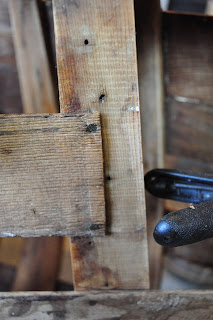These ribs are the last ones to repair on the bow end. The other ones that were less than perfect were salvaged by filling the defects with epoxy. These rib tips will be covered by a cap strip, so they don't have to look good, they just need to be a good structural joint. I tried to strip the last remaining finish in this area, but it still needs one more go with stripper.
I have been cutting back the broken planks so the new pieces end on a rib. On these two, I kept two of the original fasteners. The joints in the planking need to be staggered so two adjacent planks don't end on the same rib.
Here's a look at the skeleton from the inside of the bow. There are still several planks that need to be cut back, but those will wait until I have put some new planks on so I can keep the shape of the hull.












































